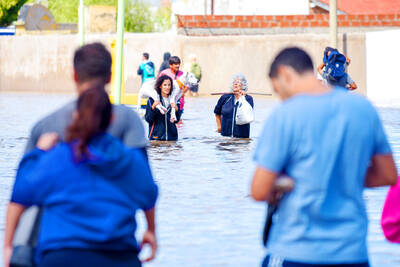Nearly half of China’s major cities are suffering “moderate to severe” levels of subsidence, putting millions of people at risk of flooding, especially as sea levels rise, according to a study of nationwide satellite data released yesterday.
The authors of the paper, published by the journal Science, found that 45 percent of China’s urban land was sinking faster than 3mm per year, with 16 percent at more than 10mm per year, driven not only by declining water tables, but also the sheer weight of the built environment.
With China’s urban population already in excess of 900 million people, “even a small portion of subsiding land in China could therefore translate into a substantial threat to urban life,” said the team of researchers led by Ao Zurui (敖祖銳) of South China Normal University.
Subsidence already costs China more than 7.5 billion yuan (US$1.04 billion) in annual losses, and within the next century, nearly one-quarter of coastal land could actually be lower than sea level, putting hundreds of millions of people at an even greater risk of inundation.
“It really brings home that this is for China a national problem and not a problem in just one or two places,” said Robert Nicholls of the Tyndall Centre for Climate Change Research at the University of East Anglia. “And it is a microcosm of what is happening around the rest of the world.”
The northern city of Tianjin, home to more than 15 million people, was identified as one of the worst-hit. Last year, 3,000 residents were evacuated after a “sudden geological disaster” that investigators blamed on water depletion as well as the construction of geothermal wells.
Many of China’s old coal districts have also suffered as a result of overmining, with authorities often forced to inject concrete into the crumbling shafts to reinforce the land.
The problem is not limited to China.
A separate study published in February said that about 6.3 million square kilometers of land across the globe was at risk. Among the worst-hit nations is Indonesia, with large parts of the capital, Jakarta, now below sea level.
Nicholls said vulnerable cities could learn lessons from Tokyo, which sank by about 5m until it banned groundwater extraction in the 1970s.
“Subsidence mitigation should be looked at very seriously, but you can’t stop all of it so you are talking about adaptation and building dykes,” he said.
Of the 44 major coastal cities suffering from the problem, 30 were in Asia, according to a 2022 Singapore study.
“It is a problem of urbanization and population growth — larger population density, more water extracted [and] more subsidence,” said Matt Wei, a geophysics expert at the University of Rhode Island.

ANGER: A video shared online showed residents in a neighborhood confronting the national security minister, attempting to drag her toward floodwaters Argentina’s port city of Bahia Blanca has been “destroyed” after being pummeled by a year’s worth of rain in a matter of hours, killing 13 and driving hundreds from their homes, authorities said on Saturday. Two young girls — reportedly aged four and one — were missing after possibly being swept away by floodwaters in the wake of Friday’s storm. The deluge left hospital rooms underwater, turned neighborhoods into islands and cut electricity to swaths of the city. Argentine Minister of National Security Patricia Bullrich said Bahia Blanca was “destroyed.” The death toll rose to 13 on Saturday, up from 10 on Friday, authorities

Two daughters of an Argentine mountaineer who died on an icy peak 40 years ago have retrieved his backpack from the spot — finding camera film inside that allowed them a glimpse of some of his final experiences. Guillermo Vieiro was 44 when he died in 1985 — as did his climbing partner — while descending Argentina’s Tupungato lava dome, one of the highest peaks in the Americas. Last year, his backpack was spotted on a slope by mountaineer Gabriela Cavallaro, who examined it and contacted Vieiro’s daughters Guadalupe, 40, and Azul, 44. Last month, the three set out with four other guides

Local officials from Russia’s ruling party have caused controversy by presenting mothers of soldiers killed in Ukraine with gifts of meat grinders, an appliance widely used to describe Russia’s brutal tactics on the front line. The United Russia party in the northern Murmansk region posted photographs on social media showing officials smiling as they visited bereaved mothers with gifts of flowers and boxed meat grinders for International Women’s Day on Saturday, which is widely celebrated in Russia. The post included a message thanking the “dear moms” for their “strength of spirit and the love you put into bringing up your sons.” It

DISASTROUS VISIT: The talks in Saudi Arabia come after an altercation at the White House that led to the Ukrainian president leaving without signing a minerals deal Ukrainian President Volodymyr Zelenskiy was due to arrive in Saudi Arabia yesterday, a day ahead of crucial talks between Ukrainian and US officials on ending the war with Russia. Highly anticipated negotiations today on resolving the three-year conflict would see US and Ukrainian officials meet for the first time since Zelenskiy’s disastrous White House visit last month. Zelenskiy yesterday said that he would meet Saudi Arabian Crown Prince Mohammed bin Salman, the nation’s de facto leader, after which his team “will stay for a meeting on Tuesday with the American team.” At the talks in the Red Sea port city of Jeddah, US